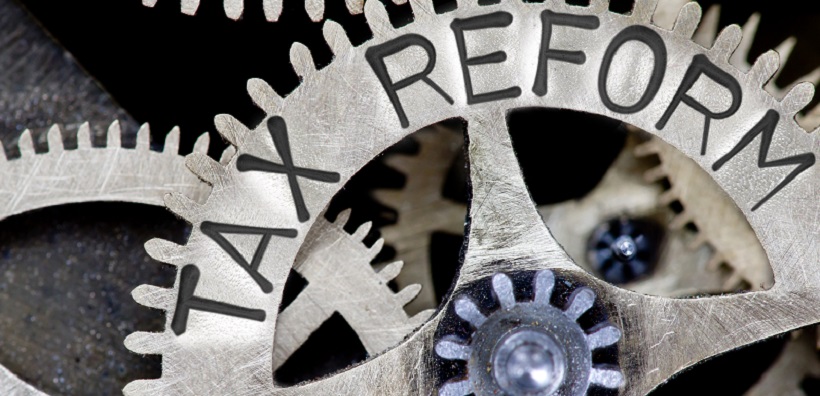A draft of the tax reform legislation was released on Thursday by the House Ways and Means Committee. Many of the provisions listed in the republicans’ September tax reform framework are incorporated in the Tax Cuts and Job Act, H.R. 1 along with new details. Federal government revenue is eligible to be cut by up to $5.1 trillion over the next 10 years with the budget legislation passed in October. It would still be enacted under the Senate’s budget reconciliation rules only requiring 51 votes for passage in the Senate. An estimate of revenue effects of the bill was released on Thursday by the Joint Committee on taxation. The estimate showed a net total revenue loss of $1.487 trillion over 10 years.
Some features of the bill include:
- New tax rates
- Repeal of most deductions for individuals
- Lower limit on the deductibility of home mortgage interest
- Full expensing of depreciable assets by businesses
These are among many other provisions of the bill. The bill does not include lowering contributions limits for Sec. 401(k) plans. However, lawmakers have reportedly discussed changes to these limits.
Sources have reported that the Senate Finance Committee is drafting their own version of the tax reform. It’s rumored it will be released next week. The Senate Finance Committee’s bill may differ from the House bill released on Thursday. The amount of variance between the bills is unclear.
Currently tax rates are as follows: 10%, 15%, 25%, 28%, 33%, 35%, and 39.6%.
Effective for tax years after 2017, the bill would impose four tax rates on individuals: 12%, 25%, 35%, and 39.5%.
The 25% tax bracket would apply to:
- Taxable income starting at $45,000 for single taxpayers
- Taxable income starting at $90,000 for married taxpayer filing jointly
The 33% tax bracket would apply to:
- Taxable income starting at $200,000 for single taxpayers
- Taxable income starting at $260,000 for married taxpayers filing jointly
The 39.6% tax bracket would apply to:
All taxable income over $500,000 for single taxpayers
- All taxable income over $1 million for joint filers
Personal Exemptions And Standard Deduction:
Single taxpayers standard deduction would increase from $6,350 to $12,200. A standard deduction of $18,300 would apply to single filers with at least one qualifying child. A standard deduction increase of $12,700 to $24,000 would apply to married couples filing jointly. The personal exemption would be eliminated and amounts would be adjusted for initiation after 2019.
Most Deductions Would Be Repealed Including:
- Medical expense deduction
- Casualty loss deductions (personal casualty loses associated with special disaster relief legislation would be exempt)
- Alimony deduction
Deductions for charitable contributions and mortgage interest contributions would be retained. For all existing mortgages, deductions would remain the same. The current limit on deductibility is $1.1 million on acquisition indebtedness. For debt incurred after Nov. 2, 2017 on newly purchased residences deducibility would be decreased to $500,000 on acquisition indebtedness.
Starting after Dec. 31, 2017 some rules for charitable contributions would change:
- Limitation increased from the current rate of 50% to 60%
- State and local income deduction would be eliminated (sales tax or income would remain deductible if being carried out for a trade or business producing income)
- Deductions would continue to be permitted for state and local real property taxes up to $10,000
The Bill Would Appeal Various Credits Including:
- Adoption tax credit
- Credit for elderly and the totally and permanently disabled
- Credit associated with mortgage credit certificates
- Credit for plug-in electric vehicles
- Child tax credit increase from $1,000 to $1,600
- Nonchild dependents would be allowed a $300 credit (expires after 2022)
- Other dependents would qualify for a new “family flexibility” credit of $300 (expires after 2022)
- The American opportunity tax credit, lifetime learning credit, and Hope scholarship credit would be combined into one credit. On the first $2,000 of eligible higher education expense a 100% tax credit would be provided. The next $2,000 would be eligible a 25% credit. This would be effective for tax years after 2017.
After 2017 contributions to Coverdell education savings account with the exception of rollover contributions would be prohibited. If taxpayers have a Coverdell ESA Sec. 529 plan they would be allowed to roll over money into it.
Deductions For The Following Would Be Repealed By The Bill:
- Interest on education loans
- Qualified tuition and related expenses
- Exclusion for interest on U.S. savings bonds used to pay higher education qualified expenses
- Exclusion for qualified tuition reduction programs
- Exclusion for employer-provided education assistance programs
The alternative minimum tax would be repealed with the bill. After 2023 estate tax would be repealed and inherited property retained would be on a step-up basis. Currently the estate tax exclusion amount is $5,490,000, indexed for inflation. The bill would double this amount. There would be a decrease in the top gift rate to 35%.
Pass-Through Income:
Net income from pass-through entities would be taxed at a maximum rate of 25%. This would be effective for tax years after 2017 and would replace taxes at ordinary income rates. Provisions that enable wages to be converted to pass-through distributions are included in the bill. A 25% rate would always be issued to passive activity income.
Income generated from non-passive business activities (including wages), owners, and shareholders could be generally elected to treat 20% of the total income as eligible for the 25% rate. The remaining 70% of the income would be eligible for ordinary income tax rates. A facts-and circumstances formula can be applied by owners and shareholders.
The bill includes specified activities defined in Sec. 1202(e)(3)(A). These activities consist of any trade or business involving services in the fields of:
-Health
– Engineering
– Law
– Accounting
– Architecture
– Agricultural science
– Consulting
– Performing arts
– Financial services
– Athletics
– Brokerage services
– Any trade or business where the principal asset is the reputation or skill of 1+ employees (this includes investing, trading, dealing in securities, partnership interest, or commodities)
Specified service activities would have an applicable percentage eligible for the 25% rate would be zero.
Business Provisions: Flat Corporate Rate
A flat rate of 20%, 25% for personal services corporations, would replace the current four-tier schedule for corporate rates. The current four-tier rates are 15%, 25%, 34%, and 35%. The 24% rate has a threshold of $75,001. The individual AMT would be repealed along with the corporate AMT.
Higher Expensing Levels:
Qualified property acquired and placed in service after Sep. 27, 2017 and before Jan. 1, 2023 (with an additional year for longer-production-period property) would be provided with a 100% expensing by the bill. Sec. 179, expensing limitation ceiling and phase-out threshold, would have an increased tenfold to $5 million and $20 million, respectively, both indexed for inflation.
The Cash Accounting Method:
The cash accounting method would be more widely available with an increase to $25 million. Some businesses are permitted to use the cash method of accounting and extend it to business with inventories. These businesses currently have a $5 million average ceiling of gross receipts and would be exempt from the uniform capitalizations (UNICAP). The percentage-of-completion method for long-term contracts resulting from the exemption would increase to $25 million in average gross receipts. This would be an increase from the current average in gross receipts of $10 million.
NOL Deductions Limited to 90% of Taxable Income:
The bill would implement an indefinite carry forward point for NOLs. However it would also eliminate carry backs available for most businesses. An interest factor would be applied to losses from carry forwards arising after 2017.
Other Deductions Would Be Curtailed Or Eliminated:
- 163(j). This section currently provides limitations for business deductions on interest paid to a related party or limitations based on taxpayer’s debt-equity ratio or percentage of adjusted taxable income. The bill would impose a limit on all businesses with more than $25 million in average gross receipts. The new limit imposed would be 30% of adjusted taxable income.
- 199. The new bill would repeal domestic production activities.
The bill would also eliminate deductions for entertainment, amusement, or recreation activities as a business expense. These deductions would also include employee fringe benefits for transportation and certain other perks considered as personal in nature rather than directly related to a business or trade. If these benefits are classified as taxable compensation to an employee or includible in gross income of a recipient who is not an employee they may be an exempt.
Like-kind exchanges would be limited to real estate by the new bill. Sec. 1031 covers exchanges of personal property and includes a transition rule to allow the completion of currently pending property.




